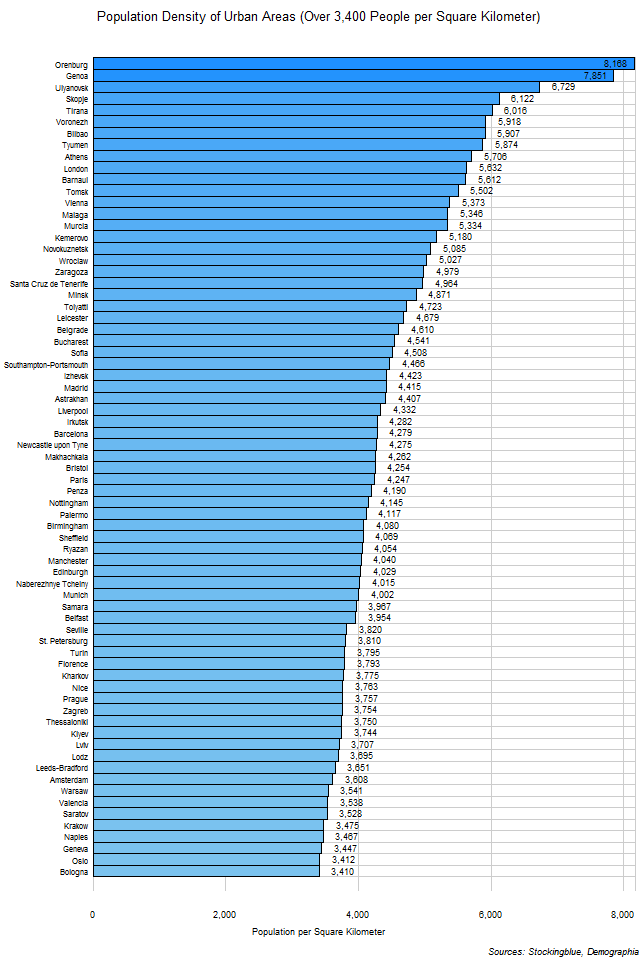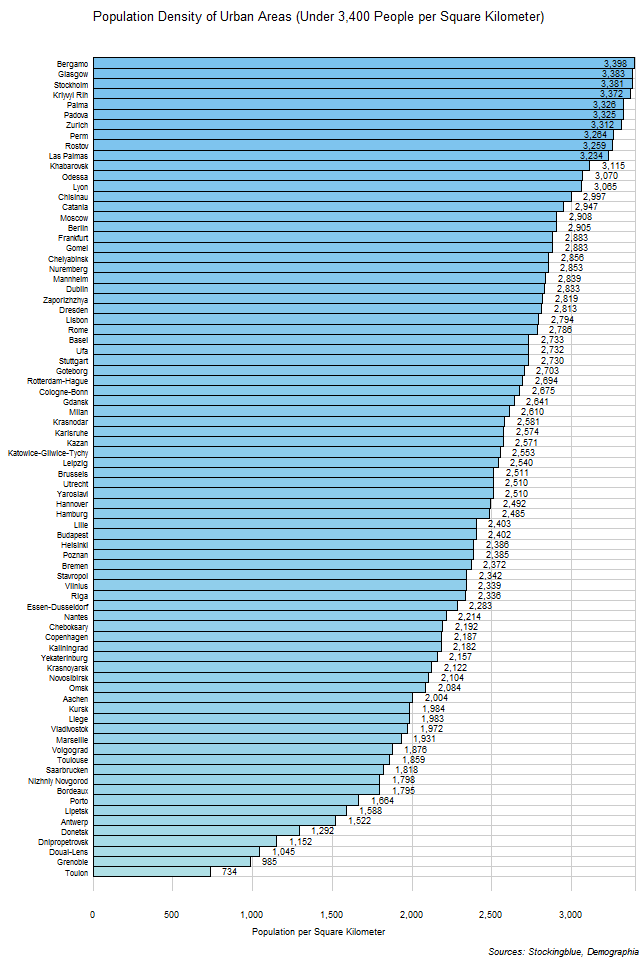
The chart above shows the population density of each urban area with a population of over 500,000 with a population density over 3,400 people per square kilometer (8,806 people per square mile) while the chart below shows all urban areas with a population of over 500,000 with a population density under 3,400 people per square kilometer. The urban areas have been normalized so as to avoid any inconsistencies with how cities and their metropolitan areas are defined by their governments. Each urban area has similar characteristics making this the definitive method with which to compare cities across various countries. Russia has the largest urban area by population density followed by Italy.
Findings

- The difference between the urban area with the greatest population density, Orenburg, and the urban area with the least, Toulon, is 7,434 people per square kilometer (19,254 people per square mile).
- Orenburg has 11.13 times the population density that Toulon does.
- The median population density of urban areas with a minimum population of 500,000 in Europe is 3,326 people per square kilometer (8,614 people per square mile) and the mean 3,428.86 people per square kilometer (8,880.71 people per square mile).
Caveats
- Data is from 2020.
- The methodology for how these urban areas have been defined can be found in the source link below. As of this writing this is the most reliable way to compare urban areas throughout the world.
- Some of these urban areas span several states, and the state that is being used here is the one where the core of the urban area is located. For instance, Milan's urban area spans both Italy and Switzerland, but since the core of the urban area is in Italy it would be listed as an Italian urban area and not a Swiss one.
- All figures are rounded to the nearest whole.
Details
Only 31 of the 51 European states have urban areas with at least 500,000 people. Of these, Russia has 40; Germany has 16; the United Kingdom has 14; France, Italy, and Spain each have 11; Ukraine has eight; Poland has seven; Belgium, the Netherlands, and Switzerland each have three; Belarus, Greece, Portugal, and Sweden each have two; and Albania, Austria, Bulgaria, Croatia, Czechia, Denmark, Finland, Hungary, Ireland, Latvia, Lithuania, Moldova, North Macedonia, Norway, Romania, and Serbia each have one.
Three of the five urban areas with a population of over 500,000 people that have a population density of over 6,000 people per square kilometer (15,540 people per square mile) are located in Mediterranean countries; Russia has the other two. The two urban areas with a population of over 500,000 people that have a population density less than 1,000 people per square kilometer (2,590 people per square mile) are located in France.
North Macedonia has the largest mean population density in its urban areas of over 500,000 people with a mean of 6,122 people per square kilometer (15,856 people per square mile) distributed among its one urban area. Albania has the second largest mean population density in its urban areas of over 500,000 people with a mean of 6,016 people per square kilometer (15,581 people per square mile) distributed among its one urban area.
The Aland Islands, Andorra, Bosnia and Herzegovina, Estonia, the Faroe Islands, Gibraltar, Guernsey, Iceland, the Isle of Man, Jersey, Liechtenstein, Luxembourg, Malta, Monaco, Montenegro, San Marino, Slovakia, Slovenia, Svalbard and Jan Mayen, and the Vatican City do not have any urban areas with a population of over 500,000 inhabitants.
Sources
Demographia. 2021. "Demographia World Urban Areas: 16th Annual Edition." Accessed March 9, 2021. http://demographia.com/db-worldua.pdf.